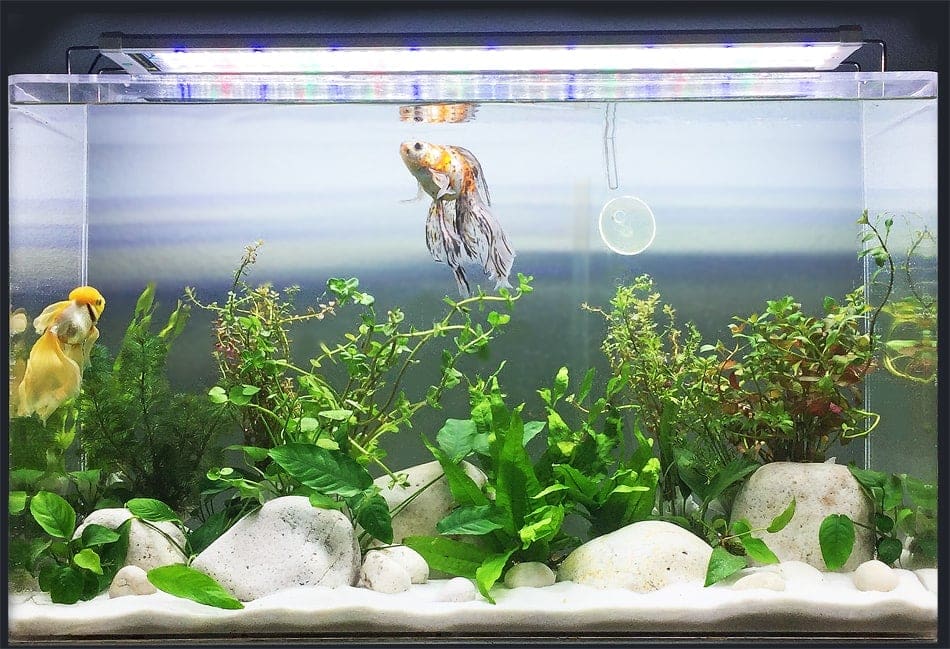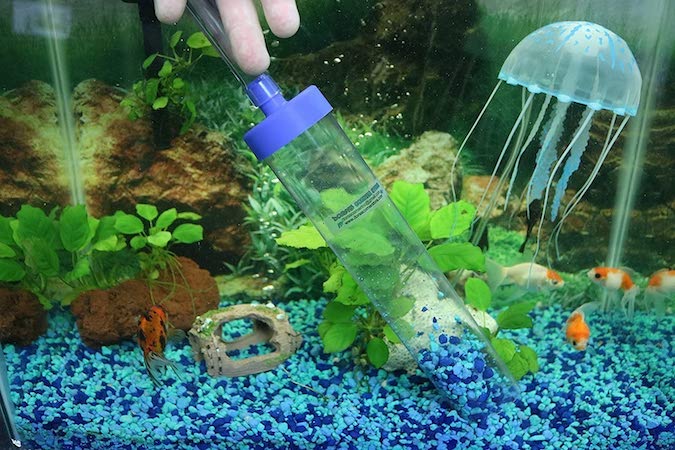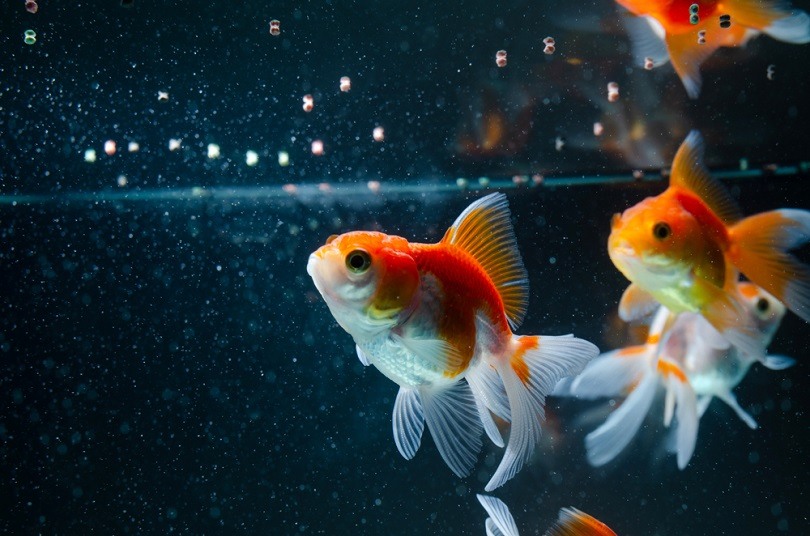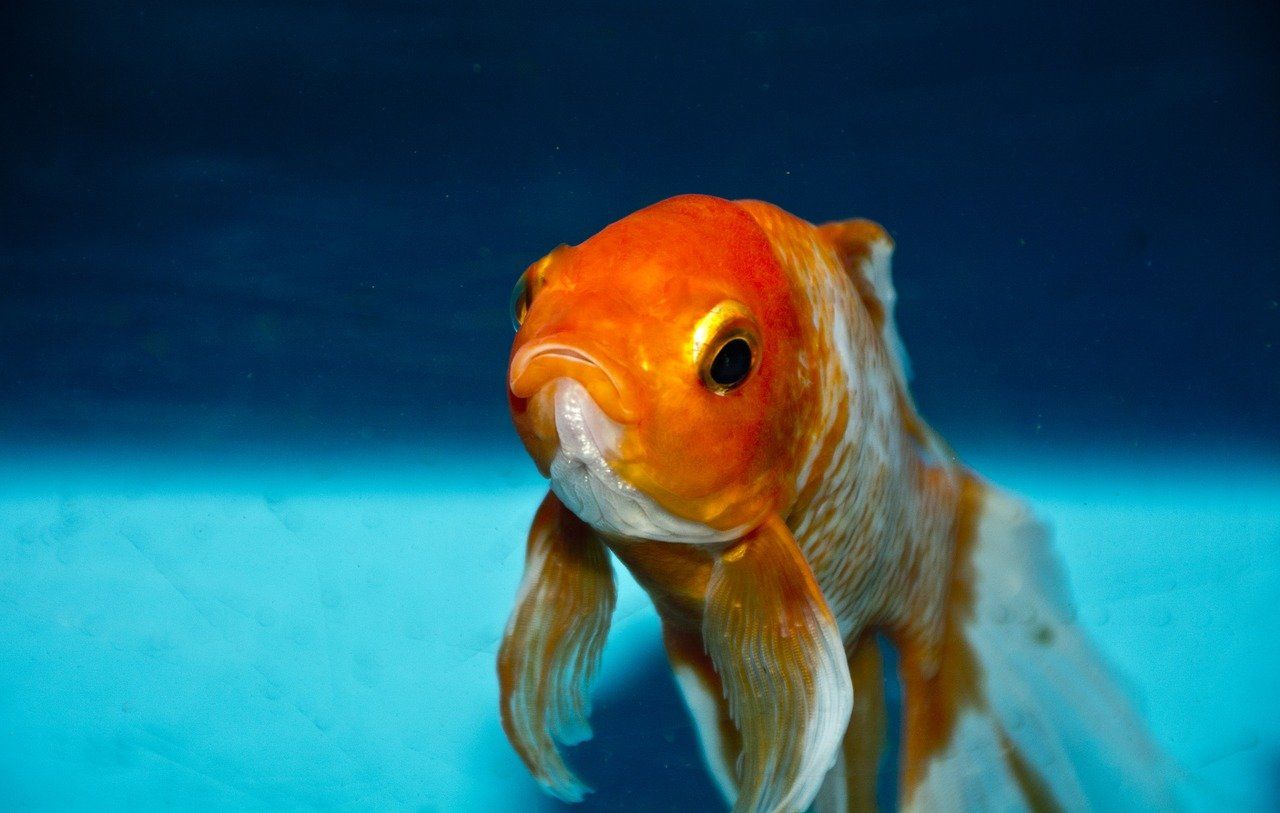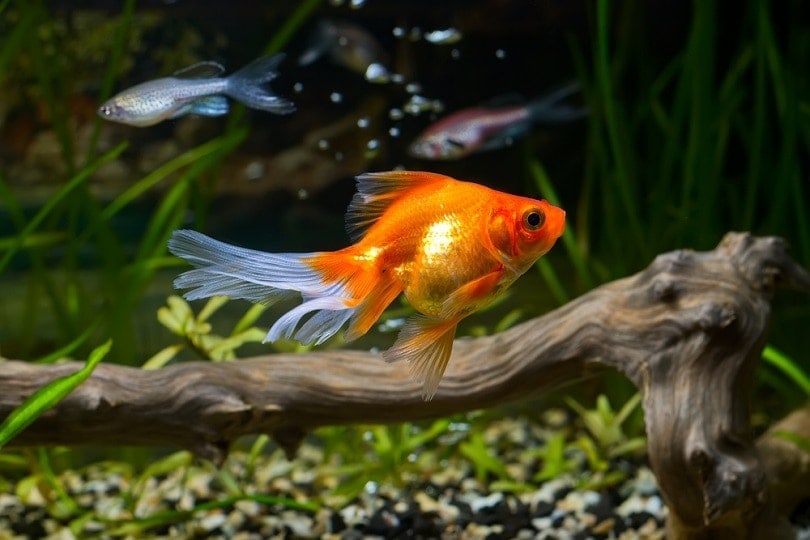8 Best Substrates for Goldfish Tanks 2024: Reviews & Top Picks

Updated on
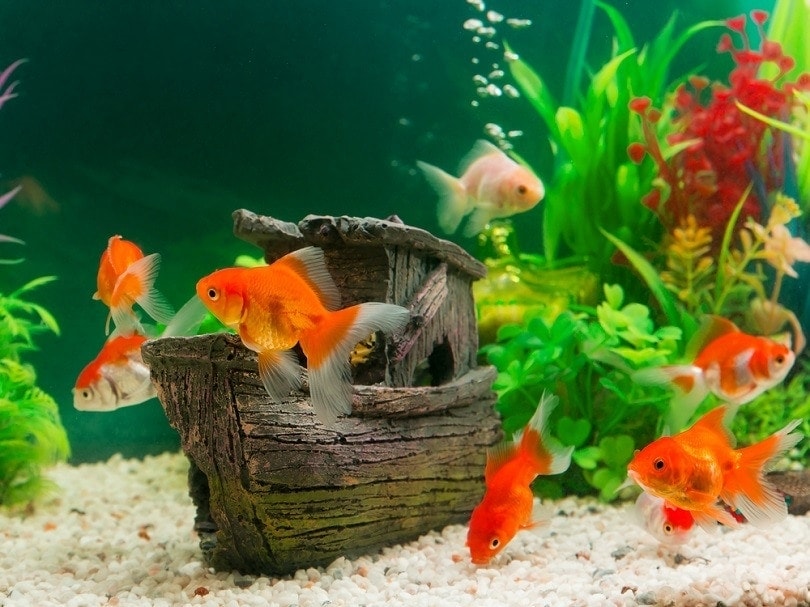
As goldfish owners, we all know that goldfish are messy fish. They create a lot of waste and are notorious for re-scaping your aquascape to their preference that day. Goldfish will also put just about anything into their mouths that they can fit, which means that gravel can be a choking hazard. Many people report having to pull gravel from their goldfish’s mouth.
So, what’s the alternative? Some people choose a bare-bottom tank, but many people don’t like the appearance. Sand is an excellent substrate for goldfish tanks, improving water quality and the health of your fish, encouraging beneficial bacteria growth and preventing choking.
Sand is not without problems, though, so care must be taken to keep it from clogging filter fans. It also needs routine stirring to prevent gas buildup, unless you have well-established, rooted plants in the tank.
We’ve put together these reviews of our top products for goldfish sand substrates to help you create a healthier, happier tank for your goldfish.
A Quick Glance At Our Favorites in 2024
| Rating | Image | Product | Details | |
|---|---|---|---|---|
| Best Overall |

|
Aqua Terra Aquarium Sand |
|
Check Price |
| Best Value |

|
Imagitarium White Aquarium Sand |
|
Check Price |
| Premium Choice |

|
Carib Sea ACS05839 Sunset Gold Sand |
|
Check Price |

|
Stoney River White Aquatic Sand |
|
Check Price | |

|
Nature’s Ocean No.1 Aragonite Sand |
|
Check Price |
The 8 Best Goldfish Substrate Options
1. Aqua Terra Aquarium Sand – Best Overall
The Aqua Terra Aquarium Sand is our choice for the best overall sand for a goldfish tank. This sand is very soft and fine, making it a great option for goldfish who enjoy digging and foraging. As with any new substrate, you may see some water cloudiness, but if rinsed properly this substrate will not cloud your water for very long, if at all.
This sand is available in 5-pound bags, making this a cost-effective option even for small tanks. There are multiple color options, but the most natural color options are a lovely, bright white and a beachy-looking tan. The sand is acrylic-coated and colorfast, guaranteeing to not fade or leach into your water.
This substrate will increase the available surface area in your tank for the growth of beneficial bacteria, improving your water quality over time. This sand is safe for fish, invertebrates, reptiles, and amphibians.
- Very fine-grained
- Minimal water cloudiness
- Soft option for foraging
- Colorfast
- Available in 2+ colors
- Encourages beneficial bacteria growth
- Will not alter water chemistry
- Safe for fish, invertebrates, and reptiles
- Needs to be rinsed well to avoid clouding water
- Will need multiple bags for large tanks
2. Imagitarium White Aquarium Sand – Best Value
For the best goldfish sand substrate for a healthier fish tank for the money, Imagitarium White Aquarium Sand is our top pick! This product is available in 5 and 20-pound bags, making it the most cost-effective choice for tanks of any size.
This sand is a brilliant, bright white, with many reviewers commenting they were pleasantly surprised by just how bright this sand is. The white color will make fish, plants, and décor “pop” in your tank. It is also available in black. The texture is somewhat gritty, making it a very natural texture option for your tank. It is still small enough that it does not have the choking risks associated with gravel substrates. The texture is also safe for foraging fish, smooth enough that it should not injure them.
This does have less surface area than the Aqua Terra sand, so it will not encourage quite as much beneficial bacteria growth, but it still provides a large amount of surface area and will benefit the health of your tank.
- Cost-effective
- Brilliant, bright white color
- Gritty texture looks natural but shouldn’t harm fish
- Available in 2 bag sizes
- Safer than gravel
- Encourages growth of beneficial bacteria
- Minimal water cloudiness
- Available in 2 colors
- Less surface area for bacteria colonization than finer-grained sand
- May cloud water for a short period, even if rinsed well
3. Carib Sea ACS05839 Sunset Gold Sand – Premium Choice
Our favorite premium choice for aquarium sand to improve the health of your goldfish tank is Carib Sea Sunset Gold Sand. This beautiful, golden-colored sand includes flecks of different colors, just like you’d see on a beach. It is available in 5-pound bags and contains no dyes or paint.
The texture of this sand is mixed, with some pieces being very small and smooth with other pieces being grittier and slightly larger. Even the larger pieces are still safe, though, and do not carry the choking risks that gravel has. It is also soft enough to not injure scavenging and digging fish. The mixed texture of this sand means it has increased surface area for bacteria colonization.
This sand needs to be rinsed very well to decrease water clouding. Any clouding should clear quickly, though.
- Beautiful, natural gold is the primary color
- Mixed texture is still safe for fish and invertebrates
- Increased surface area for bacteria colonization
- No dyes or paint
- Safer than gravel
- Water clouding should clear quickly
- Great option for aquascaping
- Less cost-effective than other options
- May cause water cloudiness even if rinsed well
- Not one solid color
4. Stoney River White Aquatic Sand
The Stoney River White Aquatic Sand is available in 5-pound bags and can be purchased in multi-bag packs. The gritty texture is similar to the Imagitarium White Aquarium Sand at a higher price-point. The Stoney River sand is white, but it is less bright than the Imagitarium sand as well. It is also available in black.
Even with the grittier texture, this sand is soft enough for foraging and digging. It does have less surface area for bacteria growth than finer-grained sand, but it will still benefit the health of the tank.
Reviewers note that this sand works well for rooting plants and stands out beautifully against dark backgrounds and décor. It does require some rinsing, but the amount of rinsing should be relatively minimal compared to some other options.
- Available in multi-bag packs
- Gritty texture is good for plants
- Safe for foraging and digging fish
- Available in 2 colors
- Encourages beneficial bacteria growth
- Requires minimal rinsing
- Will not alter water parameters
- Less cost-effective than other options
- Less surface area for bacteria colonization than finer-grained sand
- Less bright coloration than other options
If you're a new or experienced goldfish owner who’s experiencing issues understanding the best substrate for your pets, you should check out our best-selling book, The Truth About Goldfish, which covers everything about creating the most ideal tank setup and more!
5. Nature’s Ocean No.1 Aragonite Sand
Nature’s Ocean Aragonite Sand is saltwater sand that can be safely used in freshwater tanks. It is sourced from the ocean and is a natural tan color. This sand is gritty but is still safe for goldfish who forage and dig, as well as other tankmates.
This sand will leach trace minerals into the water, increasing the hardness of the water. This will also raise the pH of your tank, so you will need to monitor your pH closely since goldfish will do best in a neutral pH environment. It will help colonize beneficial bacteria and reduce nitrate levels in your tank. It is heat sterilized and pre-rinsed, so this sand will require minimal rinsing before use.
This sand is only available in the tan color, so it’s not a good option for anyone preferring something more specific. It also is only available in 20-pound bags and is the most premium-cost product we reviewed.
- Reduces nitrates
- 20-pound bag size great for larger tanks
- Can be used in saltwater and freshwater tanks
- Heat sterilized and pre-rinsed
- Trace minerals may improve water quality
- Gritty texture is safe for foraging goldfish
- Least cost-effective product reviewed
- One natural color option
- Will increase hardness and pH
- Less surface area for bacteria colonization than finer-grained sand
6. Landen Namale Nature Aquarium Sand
Landen Namale Nature Aquarium Sand is nice, natural-colored sand with a gritty texture. Reviewers note that the gritty texture is soft enough for fish to burrow and forage without injury or discomfort. It does have less surface area for bacteria colonization than finer sands.
This sand does not have additives, dyes, or paint and should not alter water parameters. It is only available in the natural tan color and does not have other color options. It is available in 4.4 and 11-pound options and is one of the more expensive options for the amount you receive.
The lack of additives in this sand means it is not nutrient-dense, so it is not a good option for tanks with plants that require a nutrient-rich substrate. If used in planted tanks, it’s best to combine it with nutrient-rich aquarium soil, which will likely double the cost.
- Soft enough for foraging and digging
- Natural tan color
- No chemical additives
- Lacks nutrients for planting
- Less surface area for bacteria colonization than finer sand
- Only available in one color
- Not very cost-effective
- Largest bag size is only 11 pounds
7. FairmountSantrol AquaQuartz-50 Pool Filter Sand
As the FairmountSantrol AquaQuartz Pool Filter Sand name indicates, this sand is intended for pool filters. Pool filter sand is one of the most cost-effective ways to put a sand substrate in your tank. Pool filter sand is made to not clog filters, making it a good choice for aquariums as well.
This sand is a natural shade of white and has no added chemicals, which is necessary to check for when using pool filter sand in an aquarium. Since this sand is made for function overlooks, there are no color or texture options. It also only comes in 50-pound bags, making it a cost-effective option for large tanks but a poor option for tanks less than 50 gallons or so.
This sand is very soft and fine, making it safe for foraging and digging. However, it is so fine and lightweight that it should not be used in tanks with much current because it is easy to get pushed out of place by water currents. The lightweight nature of this sand also makes it not the best option for goldfish tanks since they will easily pull plants up out of it and they will happily re-scape your tank once your back is turned.
- Natural white color
- Cost-effective for large tanks
- Soft and safe for foraging
- High surface area for bacteria colonization
- Not cost-effective for small tanks
- Only available in 50-pound bags
- Only available in one color
- Extremely fine and lightweight, making it easily moved by currents
- Goldfish will easily uproot plants from this fine sand
- May get picked up by gravel vacuum
- May be removed by filtration and cleaning, requiring replacement over time
8. Seachem Fluorite Black Sand
The Seachem Fluorite Black Sand is clay-based sand for planted tanks, but it is not nutrient-rich. It is not very cost-effective, though, although it should not require replacement over time. Fluorite is denser than other types of sand and may damage plants if you attempt to push the plants straight in the substrate like you can with other sand substrates.
This sand is gritty but should be safe for digging and foraging. It is porous, making it a good option for beneficial bacteria colonization. It does require rinsing before use and may cause black cloudiness in the tank. When stirred up, this sand may also release some cloudiness into the water. It should not alter pH or other water parameters.
The black color of this sand uniform, so goldfish and light-colored décor may “pop” against it, but some reviewers note it is more of a dark grey than true black. Goldfish may make a big, dark mess with this sand, re-scaping the tank to their own liking.
- Won’t alter parameters
- Good option for beneficial bacteria colonization
- Not cost-effective
- May cause black cloudiness in the water
- Can be messy with goldfish
- Best used in planted tanks
- May damage plants if not planted carefully
- Not nutrient-rich like other planted tank substrates
Buyer’s Guide
Factors to Consider:
- What else lives in your goldfish tank? All sand substrates may not be safe for all types of fish, invertebrates, aquatic reptiles, and amphibians.
- What kind of plants do you have? Plant weights can be beneficial for live and fake plants in goldfish tanks to keep the plants in place. Sand will not hold plants in place the same way gravel or stones might. Some plants require a nutrient-rich substrate, which means you may need to mix a nutrient-rich substrate with the sand.
- What look are you going for? Sand substrates are available in all different colors and textures. Attempting to create an aquascape may require different sand types than just having a basic tank floor.
- What kind of filtration do you have? HOB filters will do best with finer sand that will not clog the filter fan while grittier sand may be better suited to sponge filters. Undergravel filters can’t be used with sand.
- Will your fish, invertebrates, or plants help aerate the sand? Dangerous gases can build up in pockets below the surface of fine sand. This can be avoided by routinely stirring the sand, but burrowing fish and snails, as well as plants with extensive root systems, will naturally aerate the soil and release gas pockets. Gritty sand will naturally aerate better than fine sand.
- Do you routinely monitor your water parameters? If you put a new sand substrate in your goldfish tank, you will need to know if it is altering the pH or mineral content in your tank.
- The general rule of thumb for sand substrates is 1 pound of sand to each gallon of water. This will give you approximately 2 inches of depth.
- Make sure you purchase sand appropriate for freshwater. Some sand is made specifically for saltwater tanks and may damage the health of your goldfish tank.
- Sand substrate can be sold wet or dry, so make sure you know which you are purchasing. Dry sand is the bags of dry sand you usually see. Wet sand includes pre-colonized beneficial bacteria and will be packed in a solution that will keep the bacteria moist and alive. Wet sand may be sold labeled as the dry weight of the sand, but a 5-pound bag of wet sand may actually weigh 25-30 pounds.
- Identify what type of sand you are buying. Calcium carbonate and aragonite sands are likely to alter water parameters, while silica and quartz sands likely will not.
- If you are purchasing colored sand, ensure the colors will not leach into the water. Dyes and paints that leach into your tank can alter your water parameters as well as discoloring décor, tank equipment, and even the tank itself.
The 3 Different Substrate Options For Goldfish: Sand vs Gravel vs Bare
Ok, so when it comes to the different types of substrates that you can use for your goldfish tank, there are 3 main options.
The options for goldfish substrate include sand, gravel, and no substrate at all, otherwise known as a bare bottom tank.
Each of these substrates comes with its own advantages and disadvantages, some more than others, and there’s only 1 that is truly ideal for a goldfish tank.
1. Sand
Sand is a very popular substrate to go with for goldfish tanks, and many would say that it is indeed the number one choice.
This is something we are inclined to agree with, but let’s wait until we have taken a look at all substrate types in detail before we make a final verdict.
- Waste sits on top
- Good for diggers
- Comes in many colors
- Good bacteria
- Can handle plants
- Can make water cloudy
- Can clog filters
- Dead zones
- Not great for some plants
Sand Pros
Waste Sits on Top
One big advantage that comes with using sand as substrate is that fish waste and uneaten food sits on top of it.
Unlike with other types of substrate, because sand is so dense, waste cannot get through any cracks and sits neatly on top.
This therefore makes sand substrate quite easy to clean with an aquarium vacuum as you can just suck up the top layer of filth.
Good for Diggers
Something that really makes sand very ideal for goldfish is because it is smooth and soft. The reason why this is important for goldfish is because goldfish like to dig in the substrate and they often like to uproot plants too.
If you have some kind of sand as substrate, your goldfish can dig in it and uproot plants all it wants. Sand is soft enough so that goldfish can dig around in it without fear of injuring themselves.
Comes in Many Colors
Another cool thing about using sand as substrate is that it comes in many different colors.
This may be more important to some than others, but sand comes in all sorts of awesome colors, not just the standard golden brown.
You can get white, black, blue, and many other colors too. It can help create some nice colors and contrast in your goldfish tank.
The Good Bacteria
Yet another beneficial aspect of using sand as substrate is that it provides beneficial bacteria with a good home.
Yes, you should have a filter with biological filtration, but some bacteria laden sand can go a long way in speeding up the nitrogen cycle in your fish tank.
In other words, having sand in your tank can help to break down ammonia and nitrates much faster, thus keeping the water quality very high.
Can Still Handle Plants
What needs to be said is that while sand is not the best substrate for rooted plants, it’s not too bad.
Yes, there are a few plants which won’t do so well when rooted in sand, but there are just as many that can handle sand no problem.
You just have to find the right kind of plants for sandy substrate.
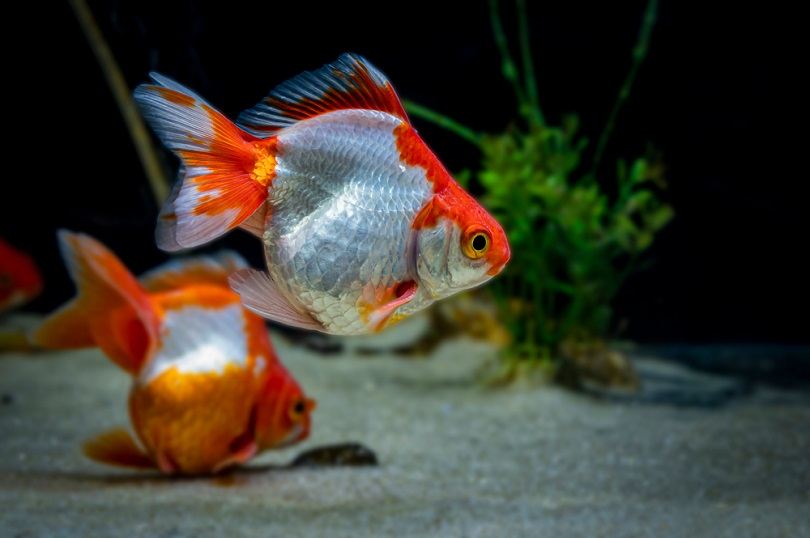
Sand Cons
Can Make Water Cloudy
As great a substrate as sand is, it does still have a few issues that need to be addressed. One of these issues is that it can make your aquarium a bit cloudy.
If you have a high-powered filter that creates a lot of water movement, it’s inevitable that some of the sand on the surface will be picked up and swept through the aquarium.
Also, seeing as goldfish like to dig, when they do, the sand will get stirred up.
Can Clog Filters
Another issue which you will face when using sand as substrate in your goldfish tank is that it can clog filters.
Because sand is so lightweight, and as noted above, because it can cloud up the water, when your filter goes to suck water in, there’s a good chance that it will suck sand in too.
At the very least, this will force you to clean your filter more often, especially the mechanical filtration media. Worst case scenario, sand can cause some serious filter clogs.
Dead Zones
One of the biggest problems you might face if you use sand as substrate is known as the dead zone, otherwise known as anoxic zones.
There are zones where over quite a long period of time, various gasses and chemicals may build up. Then, when the sand is disturbed, say by a digging fish, those toxins can be released into the water.
This can be very harmful to fish and plants. Although with that said, with good cleaning habits and regular maintenance, this really should not happen.
Not Great for Some Plants
As mentioned in the pros section above, sand is not the best for some rooted plants. Some plants that require their roots systems to grow deep and to really branch out will have trouble spreading their roots in sand.
Sand is quite dense with little to no space between grains, making it hard for plant roots to spread.
2. Gravel
The next popular option for aquarium substrate for goldfish tanks is gravel. Gravel is of course much larger and rougher than sand, and due to this, it has some advantages over sand, but for this very same reason, it also has some disadvantages when compared to sand.
Let’s take a closer look.
- Not messy
- Good for rooted plants
- Gravel is inert
- Fairly easy to clean
- Comes in a few colors
- May injure fish
- Fish may try to eat it
- Waste gets trapped
- Can clog vacuums
Gravel Pros
Not Messy
One of the advantages that comes with using gravel as substrate is that it’s not very messy.
Gravel is of course much heavier than sand, with each rock being much larger than a gran of sand. This means that gravel will not make water cloudy. Sand is light enough to float in water and can be easily stirred up, which is not the case for gravel.
This means that not only does gravel not make aquarium water cloudy, but there is also virtually no chance that it is going to clog your filter. In other words, you won’t have to clean your filter as often with gravel as with sand.
Good for Rooted Plants
Something that does need to be said about using gravel as substrate is that it is hands down the best choice to go with if you plan on having a heavily rooted tank.
The size of gravel pieces means that there is a lot of space between individual rocks. This is perfect for rooted plants that need to spread their roots.
All of that space in between rocks allows the roots to spread out very far, and each rock provides the roots with something to hold onto.
Gravel is Inert
Another benefit that comes with using gravel as goldfish tank substrate is that it is inert. In other words, gravel does not release any sort of chemicals or substances into the water.
In other words, gravel will not affect or alter water chemistry.
Fairly Easy to Clean
Gravel is also fairly easy to clean, at least in the grand scheme of things. You can take a gravel vacuum and skim over the top to get the largest pieces of debris.
When doing a full tank cleaning session, you can take the gravel out and rinse it under running water, something you definitely cannot do with sand.
Comes in a Few Colors
Although aquarium gravel does not come in as many colors as sand does, there are still quite a few choices to choose from.
You can end up making a really beautiful and highly contrasting fish tank with the right aquarium gravel.
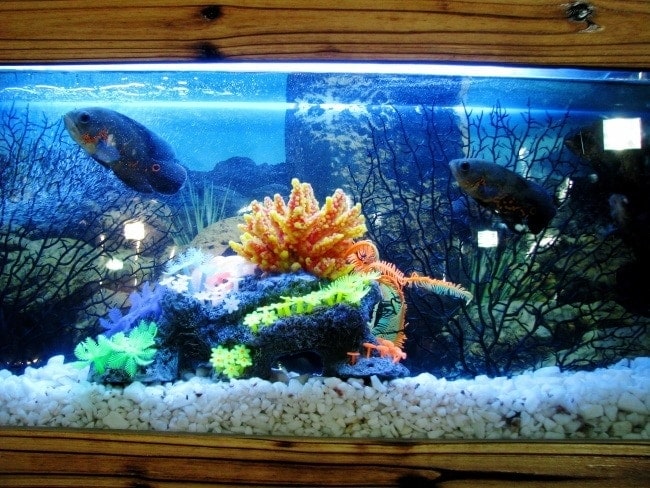
Gravel Cons
May Injure Fish
One reason why gravel is not a great substrate for goldfish is because these fish like to dig in substrate and uproot plants.
Sharp or jagged pieces of gravel can easily cut a goldfish, with the fins being susceptible to injury. Even if you have gravel that is fairly round and smooth, there is still a chance that it may cut or injure your fish in some other way.
Digging and wallowing around in gravel, especially jagged gravel, can cause serious injury to your goldfish.
Fish May Try to Eat it
Another reason why gravel is not ideal for goldfish is because they may try to eat it. If your fish eats stones, they may get stuck in the intestines, they can choke on them, and they may even cause death.
Most goldfish won’t try to eat gravel, but it does occur from time to time.
Waste Gets Trapped
The next con of using gravel as goldfish substrate is that waste can slip down in between the cracks and go all the way from the top to the bottom.
Fish waste and uneaten food can sink down into the crevices between rocks and get stuck there.
In this way, gravel is a bit harder to clean than sand, and if waste is left between the rocks for too long, it will rot, release nasty toxins, and really compromise overall water quality.
This is going to force your aquarium filter to work overtime and it certainly is not great for the health of your fish either.
It Can Clog Vacuums
Although not a huge issue, if you are vacuuming your tank out, if you don’t have a really high-quality gravel vacuum, small pieces of gravel may clog the gravel vacuum.
3. Bare Bottom
Some people do choose to go with the bare bottom method, which means having no substrate in the tank at all.
Now, this is not very popular, and it’s not something we would ever recommend for a variety of reasons.
Let’s take a closer look at why or why not you might consider not using any substrate at all.
- Easy to clean
- Inert
- Looks bad
- Can’t plant anything
- Less efficient nitrogen cycle
- No digging
- Doesn’t look like home
Bare Bottom Pros
Easy to Clean
The only real benefit that you get from not using any substrate at all is that it is easy to clean. Fish waste and uneaten food will sit right on the bare bottom, whether glass or acrylic.
There’s no substrate for waste to sink in between and there’s nothing to cloud the water or clog your filter either.
It’s Inert
Although this is a bit negligible, seeing as there is no substrate in the tank at all, there is also nothing to change the water chemistry in any way.
Bare Bottom Cons
They Look Bad
Not having any substrate at all is not great, for one, because it just does not look nice. An aquarium without some nice substrate looks drab and awkward.
Can’t Plant Anything
While a bare bottom tank does technically allow you to still use floating plants or plants that are tied to rocks or driftwood, seeing as there is no substrate at all, there is nothing for plant roots to take hold in.
Less Efficient Nitrogen Cycle
Both gravel and sand allow for the growth of beneficial bacteria on their surfaces.
However, having a bare bottom tank means that there is no such surface for those beneficial bacteria that break down ammonia and nitrates.
This slows down the nitrogen cycle, it may cause buildups of substances like ammonia, and it’s just not great for overall water quality either.
No Digging
We have noted that goldfish like to root around in the substrate.
Well, if there is no substrate, then there is nothing to dig in, something which your goldfish is not going to appreciate.
Doesn’t Look Like Home
You do want your goldfish to feel at home, and in no point in the history of the goldfish has its natural habitat every consisted of a glass bottom.
It just doesn’t look like home and it’s not cozy. This can also stress a goldfish out, especially if it sees its own reflection in the clear bottom.
Sand, Gravel, & Bare Bottom: Our Verdict
The final verdict here is that sand is hands down the number one type of substrate for goldfish tanks. Sure, sand may cloud the water a bit and it’s not the best for plant growth.
However, one of the most important aspects to pay attention to when it comes to goldfish and their substrate is digging. The only good kind of substrate to dig in is sand.
Moreover, sand is not too hard to clean, the waste sits neatly on top of it, it’s affordable, and it can come in many different colors too.
Conclusion
After reading through these reviews, what do you think would be the best fit to make your tank a healthier place for your goldfish?
We chose Aqua Terra Aquarium Sand as our best overall option for its fine-grained softness, colorfastness, and high surface area for beneficial bacteria. Imagitarium White Aquarium Sand was our top choice for the best goldfish sand substrate for the money, with its excellent cost-effectiveness, bright color, and gritty texture that even the most dedicated gravel-lover will appreciate. If you’re looking for a more premium sand choice, the Carib Sea Sunset Gold Sand is a beautiful, natural-looking option, with its beachy gold and flecks of brown and black and irregular shape between grains.
Finding the perfect aquarium sand substrate to make your goldfish tank a healthier place can be difficult, but it’s a choice made complete by your own vision of how you want your tank to look and function. Then you can use these reviews to help guide you in picking the perfect sand substrate to achieve your vision and improve your tank for the health and happiness of your goldfish.
Featured Image Credit: luckypic, Shutterstock













